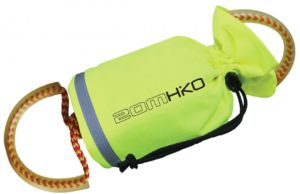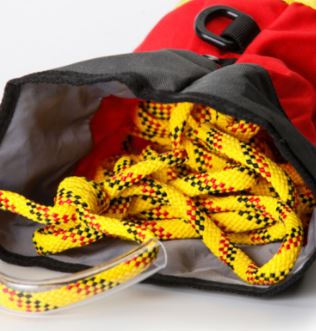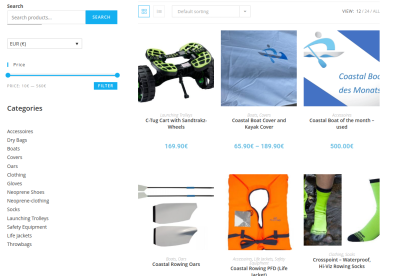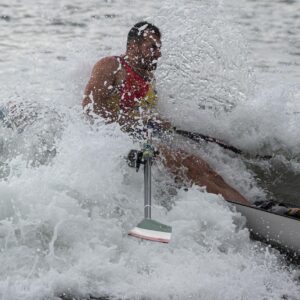In this post, we will talk about safety equipment for Coastal Rowing. In particular about the use of a throw bag. We focus hereby on a man-over-board (MOB) situation and how to help a person in need to get back on the boat.
Luckily, we are not aware of many coastal rowers in distress. At least we did not read about it. Most reports are about river rowers or sea kayakers who had to be rescued.

Functions of a throw bag:
- Rescue from MOB situations
- Use as a towline, Coastal Boat to Coastal Boat – not for motorised boats
- Keeping solo rowers connected to their skiff in rough waters
- Keep in touch with other boats – caution advised as the rope can move or twist
Emergency rescue
The throw bag can be used to help during a MOB situation, salvage a boat, or quickly build a bridge with a second boat. There are a couple of things to consider when using a throw bag from a boat toward a person in the water. Two aspects are important in particular – eye contact between the rescuer and the person in need, and a firm stand of the thrower within the boat. The throw should be done by the cox. A cox has enough space and the rest of the crew is needed to stabilise the boat. Before you start your tour you should inform your crew about the location of the bag, and other safety equipment, as well as the use of everything. Remember your last flight? And the video (or in-person) safety instruction there? Yes, there are certainly no exits behind you but all crew members should know what to do – MOB situations are always life-threatening.
Coastal Rowing suitability and score: 8/10
Our test crews from Rowing in Europe and Coastal Boats consider the bag a very useful tool on board. It does not take a lot of space, is highly mobile and can be used by all rowers on board. The additional weight you bring to the boat is neglectable. Investments are definitely justified for the benefit this tool brings.
How do I use a throw bag in coastal rowing?
Coastal Boats.eu has a range of throw bags in their shop. The supplier HIKO is a company with a lot of water sports experience. The length of the rope ranges from 15 to 30m. The rope itself lays loosely and unknotted in the bag. It sticks out of one end and is usually connected to the bag (the type of connection to the bag depends on the model and the company).

Let’s have a look at the different steps when using a throw bag in a MOB situation.
In the case of an emergency, take the end of the rope in your left hand and throw the bag with the rope toward the person in need. In the video below you can see a good way how it’s done. Please keep in mind that a water rescue by rowers is dangerous and not as easy as a rescue from a beach or shore. The rescuers should always be aware that they are not on solid ground and that the conditions might be quite wavy. So make sure, that the rescuer doesn’t become a second MOB.
- Open the throw bag
- Remove at least 2 m /7 ft of the rope
- Look for a place to stand or sit firmly in the boat
- Make sure that the end of the rope lies on your shoulder (this helps with a stabilisation)
- Establish visual contact with MOB or boat crew
- Call MOB or other boat crew
- Aim by swinging once (see throwing techniques)
- Throw the bag
- Establish a firm footing or safe seating position immediately
- Pull swimmers toward your own boat or toward the shore
Throw techniques
Underhand Toss
By far the most used technique is the underhand throw. It works well in most water rescue situations and provides the thrower with the most balance. It’s not only perfect for a throw from a boat but also from uneven undergrounds, like a rocky shore. The underhand toss makes it quite easy to aim and release the bag in the proper direction. The rescuer usually ends up in a good position to start pulling on the rope.
Overhand toss
This technique works best when the situation precludes the underhand toss, such as standing in knee-high water. The overhand toss places greater stress on the shoulders of the thrower which makes it harder to keep your balance. Some people prefer this way of throwing because it’s faster than the underhand throw. Personally, I experienced that you quite often hit the MOB in their face with this technique. It is definitely helpful when a boat is stuck in the middle of the river and the person in need is standing as you reach a comfortable height for catching the rope quite easily.
What do you have to consider when buying a throw bag?
The diameter of the rope
Ropes with a smaller diameter (below 7,5mm) are easier to throw but way more difficult to hold on to, for the person in need as well as for the thrower. We recommend a rope with a diameter between 7,5 to 15mm.
The length of the rope
Personally, I prefer a rope with a length between 15 to 20 m (50-70 ft). But you have to consider: the longer the rope, the heavier the bag. Even though it might be heavier, a rope shorter than 15 m does not make any sense. Most of the time the current or the speed of your boat has left the person in need further away and your rope might be too short. And you certainly don’t want to lose any time with turning the boat, especially in wavy conditions.
The colours of the rope
We prefer yellow, orange or green colours. Blue and white are available as well but might not be visible enough in wavy conditions.
Please keep in mind:
A rescue attempt with a throw bag might not always work! Please have always the numbers of local rescue authorities with you, as you might need them if your personal rescue attempts fail.







